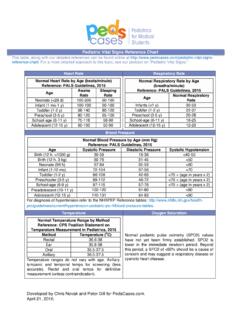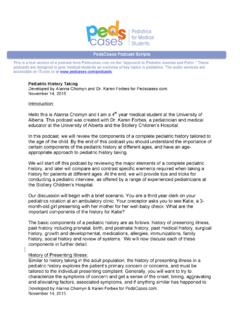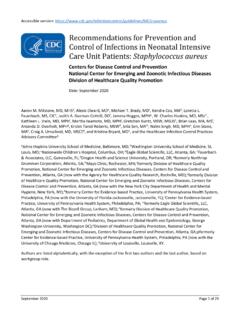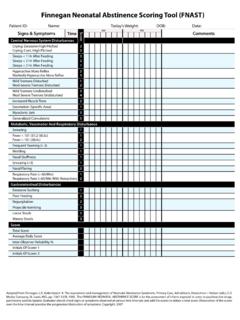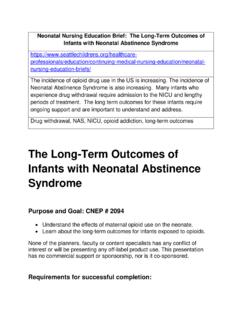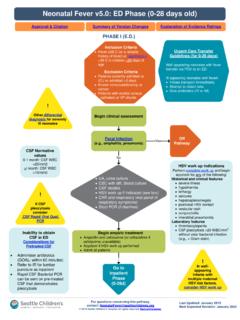Transcription of NEONATAL HYPOTHERMIA - PedsCases
1 Developed by Mekala Neelakantan and Dr. Paulomi Chaudhry for October 12, 2020. NEONATAL HYPOTHERMIA Developed by Mekala Neelakantan and Dr. Paulomi Chaudhry for October 12, 2020 Introduction Hello! My name is Mekala Neelakantan, and I am a fourth-year medical student at the Western Michigan University Homer Stryker School of Medicine in Kalamazoo, Michigan, USA. This podcast will discuss NEONATAL HYPOTHERMIA , including a case presentation and general overview of risks, symptoms, consequences, and management. It has been created under the guidance of neonatologist Dr. Paulomi Chaudhry, Assistant Professor of Clinical Pediatrics within the Section of NEONATAL -Perinatal Medicine at the Indiana University School of Medicine.
2 Learning Objectives The objectives of this podcast are to: Define NEONATAL HYPOTHERMIA . Review the pathophysiology associated with NEONATAL HYPOTHERMIA . Discuss the risk factors and consequences associated with NEONATAL HYPOTHERMIA and inadequate thermoregulation in the newborn. Underscore treatment and prevention strategies to prevent NEONATAL HYPOTHERMIA . Case Presentation Let s begin with a clinical case scenario. You are on a night shift during your Pediatrics clerkship, when you are called for the impending admission of a male newborn of low birth weight, noted to be at 29 weeks of gestational age.
3 The baby is being brought in by EMS following his unexpected home delivery and is accompanied by his mother of G1P0 status. The mother relates that she did not receive prenatal care and did not realize that she was in premature labor. Her partner called 911 as soon as they realized she was not going to make it to the hospital to deliver the baby. You notice the baby s skin is quite mottled, and tinges of blue appear near his fingers and toes. You begin the physical exam and note that the baby is bradycardic with a heart rate of 80 beats/minute and in mild respiratory distress with increased work of breathing.
4 You check his axillary temperature, which is noted to be 35 C. As we delve into the topic of HYPOTHERMIA below, keep in mind the possible causes and risk factors for the development of this condition in the newborn discussed above. Literature Review PedsCases Podcast Scripts This podcast can be accessed at , Apple Podcasting, Spotify, or your favourite podcasting app. Developed by Mekala Neelakantan and Dr. Paulomi Chaudhry for October 12, 2020. NEONATAL HYPOTHERMIA is a concern of enormous scale, significantly affecting the morbidity and mortality of the newborn population1, 2. According to the World Health Organization, the condition is prevalent in every continent.
5 The most significant ramifications are often seen in developing and low-resource areas around the world, where awareness of the issue is only beginning to be brought forth; improved techniques for prevention and treatment in more developed regions have curbed occurrences, although the problem still persists 3, 4. Reports from England note infant HYPOTHERMIA is the most common reason for morbidity prior to admission, and studies from Nepal show that the winter months portend NEONATAL HYPOTHERMIA developments in more than 80% of delivered newborns2. As such, it is vital to understand the intricacies of NEONATAL HYPOTHERMIA and continue efforts to bring awareness of the issue, especially in the context of premature infants5.
6 We will begin this review with a discussion of the definition and pathophysiology of NEONATAL HYPOTHERMIA , before moving onto the risk factors, consequences, treatment, and prevention strategies. Definition of HYPOTHERMIA in neonates: According to the World Health Organization, HYPOTHERMIA occurs at core body temperatures below 36. 5 C5. This is additionally broken down into three categories of cold stress, between 36 C and C, moderate HYPOTHERMIA , between 32 C and 35. 9 C, and severe HYPOTHERMIA , or less than 32 C1, 2, 6, 7. While these are relatively concrete numbers and categories, it is also important to recognize that the ramifications of HYPOTHERMIA may occur at even higher temperatures based upon the ensuing metabolic stress experienced by the body5.
7 In the context of the NEONATAL population, who have a limited ability to thermoregulate at baseline, this may pose stressors that have end effects on overall growth and organ function2. Pathophysiology of NEONATAL HYPOTHERMIA : Why does this happen in the first place? Well, the shiny, new environment that a newborn is brought into is fraught with thermal instability, quite the opposite from the stable setting in which the fetus grows - closely coupled with the maternal temperature in what has been described as a heat clamp 7. While there are various causes for the initial dysfunction in thermoregulation, the NEONATAL population is affected primarily by four mechanisms of HYPOTHERMIA : radiation (an infant being placed in a setting containing cooler materials without direct contact, therefore creating a gradient for temperature loss), evaporation (the most important cause, often from amniotic fluid evaporation), conduction (an inadequately wrapped infant being directly placed in contact with a cooler object) , and convection (surrounding cold air causing removal of heat from the infant)5, 8.
8 The stress due to heat loss leads to a significant change in metabolic function of the neonate, as energy is shifted toward increasing heat rather than toward growth and development5, 8. Newborns utilize various different mechanisms to battle the cold stress being experienced by their bodies - including increased energy and heat production by organs such as the heart, liver, and brain; muscle flexion to generate heat from voluntary movements as well as minimize surface area; peripheral constriction of blood vessels to decrease heat dissipation, This is where non-shivering thermogenesis comes in8. In a mechanism by the sympathetic nervous system triggered by cold stress, neonates utilize the norepinephrine - directed lipolysis of brown adipose (most commonly around the neck, Developed by Mekala Neelakantan and Dr.)
9 Paulomi Chaudhry for October 12, 2020. scapular area, and kidney regions) to create local heat reactions that are carried throughout the rest of the bloodstream to warm the body5. The downsides to this, however, are that these neonates subsequently experience a rapid increase in overall metabolic rate that can then lead to hypoxia and hypoglycemia as the stores of brown fat are used up with consumption of oxygen and glucose in the process; it is then easy to see that when applied to a premature infant with underdeveloped vital organs, such an elevated energy requirement can lead to unfortunate consequences such as organ damage, metabolic acidosis, and hypoxia1, 5, 8.
10 Additionally, the premature infant may not even have the limited capacity to generate heat under cold stress conditions, as their bodies contain less brown adipose and overall fat stores1. Risk factors and causes for NEONATAL HYPOTHERMIA : We will talk about consequences more in-depth in a couple of minutes, but first, let us transition to a discussion of what most commonly places neonates at risk for HYPOTHERMIA . It is easiest to present risk factors and causes for NEONATAL HYPOTHERMIA by housing them in various different categories1, 6: Number 1, quite importantly, encompasses the premature neonate, who, as we discussed previously, have a higher risk of developing HYPOTHERMIA .
